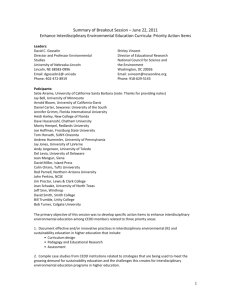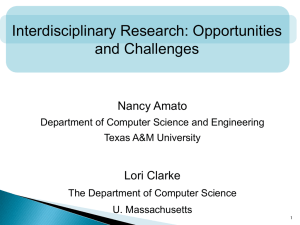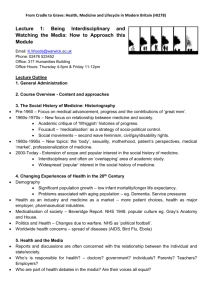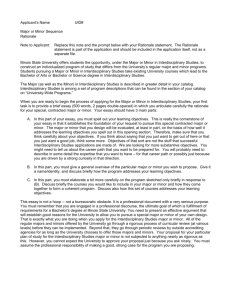Environmental Education in the 21st Century
advertisement
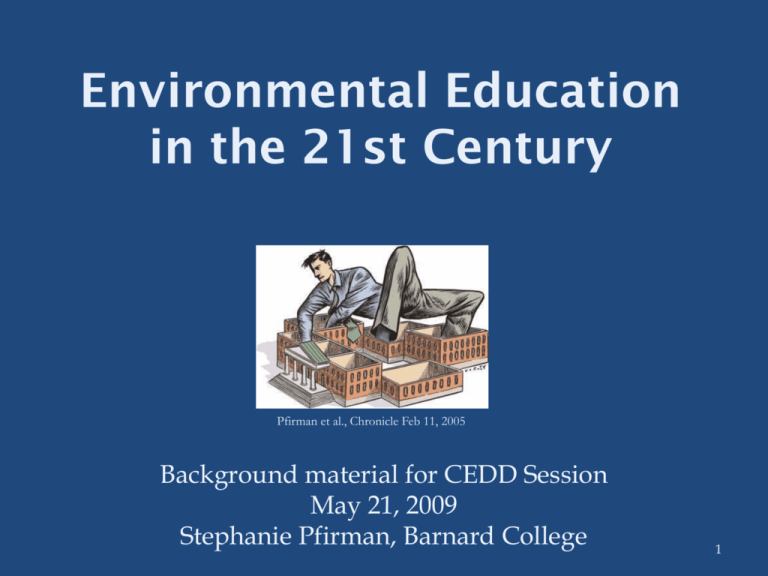
Environmental Education in the 21st Century Pfirman et al., Chronicle Feb 11, 2005 Background material for CEDD Session May 21, 2009 Stephanie Pfirman, Barnard College 1 EDUCATIONAL TRENDS 2 LEAP: Proportion of employers who say colleges and universities should place more emphasis than they do today on: Concepts,new developments in science and technology …….. Teamwork, collaborate with others in diverse group settings Apply knowledge and skills to real-world settings through internships or other hands-on experiences …………………..……… Effectively communicate orally and in writing …………..…………. Critical thinking and analytical reasoning skills ……………………… Global issues, developments, implications for the future ……… Locate, organize, evaluate information from multiple sources Innovate, think creatively ………….…..…………..………………………… Solve complex problems ……………………………………….……..…..….. Work with numbers and understand statistics …………….……….. 82% 76% 73% 73% 73% 72% 70% 70% 64% 60% 3 http://www.aacu.org/LEAP/index.cfm Pedagogy for the 21st Century 1. Learner at the center – Multiple learning styles – Adapts education to learning needs of each individual 2. Repertoire of teaching strategies and skills – Traditional education systems fostered the obedience demanded of the manufacturing workforce – Future education must nurture creative and collaborative skills. Knowledge available at the click of a mouse -learning to apply it requires teachers who instruct, facilitate, guide, and support Equipping Every Learner for the 21st Century,4 2008 Developed by the Centre for Strategic Education, Cisco Systems, Inc., and McKinsey & Company Pedagogy for the 21st Century, continued 3. Interdisciplinary and project-based work – – In complex areas, learn how to draw on multiple disciplines and recognize interdependence Working in teams, link between 21st century skills and the pedagogy used to impart them 4. Authenticity – Appeal to existing interests – Integrate real-life experiences into lessons: students do not just make an architectural drawing, they actually build a structure on the school lawn. – Learning that extends beyond the classroom into the community, the wilderness, the workplace, and the virtual world Equipping Every Learner for the 21st Century,5 2008 Developed by the Centre for Strategic Education, Cisco Systems, Inc., and McKinsey & Company Pedagogy for the 21st Century, continued 3. Interdisciplinary and project-based work – – In complex areas, learn how to draw on multiple disciplines and recognize interdependence Working in teams, link between 21st century skills and the pedagogy used to impart them 4. Authenticity – Appeal to existing interests – Integrate real-life experiences into lessons: students do not just make an architectural drawing, they actually build a structure on the school lawn. – Learning that extends beyond the classroom into the community, the wilderness, the workplace, and the virtual world Equipping Every Learner for the 21st Century,6 2008 Developed by the Centre for Strategic Education, Cisco Systems, Inc., and McKinsey & Company “Environment” Moving Beyond “Earth Systems Science” 7 Presented by Tim Killeen, NSF AD for Geoscience, CEDD winter meeting, 2008 Growth in “Environment/Sustainability/ Sustainable Development” How has environmental student enrollment changed over the past five years? Vincent and Focht (CEDD Curriculum Study, in prep.) 8 Potential for New Environmental Masters Degrees 80 Do you intend to pursue any additional degrees? 70 60 50 40 30 20 10 0 Master's Unsure No PhD Other JD MD 9 Shukla and Freeman Results from Harvard/CEDD Pilot Survey ENVIRONMENTAL ALUMNI 10 When did you decide to pursue an Environmental / Natural Resources degree? Shukla and Freeman: The Alumni Career Survey -National Bureau of Economic Research, Harvard Science and Engineering Workforce Project (http://www.nber.org/~sewp/), Council of Environmental Deans and Directors. Phase I of survey administered by 15 schools to their alumni from the class of 2005,: 157 responses, Response rate 27% Elementary School Middle School/ (or earlier) Junior High 3% School Post-grad 7% 2% High School 26% Undergrad 62% 11 What was the primary reason you decided to enter an Environmental / Natural Resources program in college? Opens doors to other fields 2% Good career opportunities 4% Potential to make societal impact 28% Other 5% www.sierraclub.org/grassroots/sto ries/00025.asp Interest/ aptitude in field 61% 12 Shukla and Freeman, CEDD/Harvard Alumni Pilot Employment 50 40 30 20 10 0 In what type of employment setting did you most WANT to work after graduation ? In what type of employment setting do you currently work? 13 Shukla and Freeman Career Choice If you are NOT currently in an Environmental /Natural Resources career, which of the factors below influenced you to consider work outside of your field? Other 22% Higher pay or promotion opportunities 17% Better working conditions 0% Better location 4% Lack of jobs in field 35% Change in career or professional interests 22% 14 Shukla and Freeman Responses In college, who gave you the most VALUABLE advice about potential career options? 70 60 50 40 30 20 10 0 “New Green Economy” NCSE January 2010 15 Shukla and Freeman, CEDD/Harvard Alumni Pilot Interdisciplinary Student Advising • Students in interdisciplinary programs tend to be less well served than students in departments – Advisors with dual affiliations are more comfortable advising about courses and careers in their own disciplines • This is especially unfortunate given that women and minorities appear to be disproportionately attracted to these programs (Jill Schneiderman, Vassar) – Institutions … have a responsibility to provide them with more advising and career services than is standard for other departments, and to support that advising through increased staffing (Hempel and Pfirman, program review) 16 CEDD Curricula Survey CURRICULAR CONTENT 17 CEDD Survey of U.S. Environmental Programs: Curriculum Models and Core Competency Areas • Identified 840 programs at 652 institutions awarding 1183 degrees • Response rate 31% - 260 programs at 238 institutions awarding 343 degrees – 73% baccalaureate – 20% masters – 7% doctoral • Sample representative in Carnegie Class, census region/division, program type (level, name) Distribution of Institutions with Environmental Programs 18 CEDD Curriculum Survey Vincent and Focht (2009) Cluster analysis discovered three clusters for both undergraduate programs and graduate programs: 1) a natural science focused cluster 2) a social science and humanities focused cluster * 3) an interdisciplinary, problem-solver cluster * * These undergraduate programs had higher percentage of growth than those in the natural science focused cluster A total of 260 program leaders at 238 institutions participated in the survey for a response rate of 31%. They provided information on 343 degree programs (69% named 19 Environmental Sciences or Environmental Studies). Vincent and Focht (2009): Ranked Consensus Factors for Undergraduate Degree Programs Knowledge : (1) social sciences and humanities, (2) sustainability, applied sciences and management, (3) interdisciplinary understanding (4) life sciences (5) physical sciences Skills: (1) management skills (2) technical research and communication skills (3) cognitive skills (4) social research and communication skills (5) decision-making skills 20 CEDD Environmental Curriculum Study Survey Findings Relevant to Sustainability: Shirley Vincent and Will Focht • ca. 30% of all ID environmental degree programs consider sustainability a core principle in their curricula • > 50% include sustainability concepts in required coursework ----• 86% rate the importance of sustainability in program curricula as modest to high Vincent, S, and Focht, W. (2009) US Higher Education Environmental Program Managers’ Perspectives on Curriculum Design and Core Competencies: Implications for Sustainability as a Guiding Framework, International Journal of Sustainability in Higher Education (in press).21 Sustainability/Climate • November 2007, 6,000 students traveled across the country to participate in the three day Power Shift Conference outside Washington, DC, to learn about global warming and to lobby Congress – 10,000 are expected in 2009 • Undergraduate environmental programs that include sustainability report higher rates of growth over the past 5 years (ca. 238 institutions) – Vincent and Focht (CEDD Curriculum Survey) http://sierraclub.typepad.com/scrapb 22 ook/2007/11/power-shift-200.html 23 Academic Preparation Do you wish you had received more training in how technology developments in the following fields relate to the environment? Other 17% Energy 40% Computer Sciences 34% Nanotechnology 0% Biotechnology Medicine/Health 3% 6% 24 Shukla and Freeman CURRICULAR STRUCTURE 25 Beyond Earth Systems Science 26 Presented by Tim Killeen, NSF AD for Geoscience, CEDD winter meeting, 2008 Structuring Curricular Content Disciplinary Funnel Introductory Intermediate Capstone D or ID D D Bloom's Taxonomy? Interdisciplinary Fan D ID or D ID Sandwich ID D ID Buffet ID Knowledge, Comprehension ID Application, Analysis ID Synthesis, Evaluation 27 How to Develop Expertise? 28 Measuring researcher interdisciplinarity Alan L. Porter, Alex S. Cohen, David Roessner and Marty Perreault, 2007, Scientometrics Importance of Capstone Experience I guess, I just wanted to see what you are up to, and also to thank you because as I look back to Barnard, one of the memories that come up in my mind most often is all the classes that I took for the Environmental Science major, and even writing my thesis...(which I must admit, back then, I could not understand the purpose of writing one, but now as I look back... I realize that a lot of the projects that I am working on now resemble small theses... the research, the timing, the developing of the ideas... the editing and the collection of all thoughts into one small project...)." January, 1999. This student graduated in 1997 and – last we knew – was working as a Sr. Statistical Analyst for an Investors Service 29 ACADEMIC HOME 30 Environmental Program Analysis Barnard, Bates, Bowdoin, Colby, Colgate, Colorado College, Hobart & William Smith, Lewis & Clark, Middlebury, Mount Holyoke, Whitman Common Directions • Local environmental engagement and service learning • Interdisciplinary student research • Building community – Common spaces and resources – connecting via GIS – Campus greening & programming 31 Jill Bubier (Mt. Holyoke) and students at a wetland research site in New Hampshire Photo by Ralph Morang ES&T May 2005: Pfirman, Hall, Tietenberg PKAL 2005: Hall, Tietenberg and Pfirman Common Challenges • Staffing courses – Cross-departmental commitments – Team teaching • Staffing activities – Balancing education and scholarship – Program management – Service learning – Campus greening – Student internships 32 Diversity Faculty Students Junior people (women) in difficult positions … ES&T May 2005: Pfirman, Hall, Tietenberg PKAL 2005: Hall, Tietenberg and Pfirman Recommendations from Mellon Review • Institutions should take responsibility for interdisciplinary programs, students and faculty – Invest in community building (on campus and off) – Incentives and rewards for cross-departmental contributions – Staff programs – Institutionalize faculty career path 33 ES&T May 2005: Pfirman, Hall, Tietenberg PKAL 2005: Hall, Tietenberg and Pfirman Spectrum of Interdisciplinary Involvement Commitment and Investment Modest Intermediate Significant Students and Curriculum Minor Concentration, Special Major Major Committee Center, Program Interdisciplinary Department Affiliated Hire in Disciplinary Department Adjunct, Off-ladder, Joint Hire Tenure-track in Interdisciplinary Department Administration Faculty Research Scientists Soft-money Multi-year Support Support for Single or Shortterm Project 34 Institutioncommitted Career Interdisciplinary Research Scientist Line Pfirman et al., Chronicle Feb 11, 2005 INTERDISCIPLINARY FACULTY 35 Stereotypes of Disciplinary vs. Collaborative, Interdisciplinary Students/Scholars? Disciplinary • • • • • • • • • • • • • 36 Quantitative Tough Self-driven Independent Assertive Self-promoting, take credit for successes Careerist Risky science within the mainstream/consensus science Focused, task oriented Quick to publish, get ideas out Productive Competitive Command-and-control leadership (e.g. lab hierarchy) Collaborative, Interdisciplinary • • • • • • • • • • • • Relational, qualitative Friendly, nice Concerned about others and their welfare Helping Socially sensitive, listening Communal Less careerist Interdisciplinary science Multitasking Synthetic Not competitive Consensus oriented, democratic leadership Different Approaches to Interdisciplinary Research and Education Intrapersonal: Cognitive Connections Cross-fertilization – adapting and using ideas, approaches and information from different fields and/or disciplines Interpersonal: Collegial Connections Team-collaboration – collaborating in teams or networks that span different fields and/or disciplines Interdepartmental: Cross-field Connections Field-creation – topics that sit at the intersection or edges of multiple fields and/or disciplines Stakeholder: Community Connections Problem-orientation – problems that engage multiple stakeholders and missions outside of academe, for example that serve society 37 Rhoten and Pfirman, 2007a,b Support Multiple Levels of ID Res & Ed Intrapersonal: Cognitive Connections 38 “New directions” sabbaticals Course development Interpersonal: Collegial Connections Multiple authors, PIs Co-teaching Interdepartmental: Cross-field Connections Centers Joint majors, linked courses Stakeholder: Community Connections Research practice, applications Civic engagement 38 Rhoten and Pfirman, 2007a,b Convene Around Complex Problems Engage faculty through the affective as well as cognitive realm • Seminars/Workshops – MacGregor workshop – “One book” -- Chandler-Gilbert Community College – “Global Learning” -- Whitman • Field experiences – River Summer -- Pfirman, Kenna, Barnard/Lamont/ Environmental Consortium of Hudson Valley Colleges and Universities 39 Recognize Initiative and Reward Success • Everyone wants to others to recognize their significance – Citations, Book reviews, Fellows of Professional Societies • Create campus awards for env. teaching and research Who will deliver on America’s Promise: The Future Professoriate 40 W. Plater, J. Schuster, J. Gappa, AAC&U Seattle 2009 Make Time: Faster – Better – Teaching? • Use the entire campus – that fact that faculty and students are together – Link engineering, economics, psychology, geology, ethics, business, policy, public health • Align curricula with learning goals – Minors/Concentrations/Masters • Sustainable Development (Columbia) • Entrepreneurship (Trinity) • Leadership (Barnard) • Innovative pedagogy – Social networking as a learning tool? 41 Potential of New Approaches to Education “Here Comes Everybody: The Power of Organizing without Organizations” Clay Shirky, 2008 • “Most of the barriers to group action have collapsed, and without those barriers, we are free to explore new ways of gathering together and getting things done.” • “When a real once-in-a-lifetime change comes along we [with the experience] are at risk of regarding it as a fad.” – “… young people are taking better advantage of social tools , extending their capabilities in ways that violate old models …” 42 LOOKING AHEAD Students Develop student capacity to meet the needs of the global community … adopt “Pedagogy for the 21st Century”? Connect to entrepreneurship? Agencies/business May be getting ahead of us? Faculty Need to catch up Develop the will, capacity, incentives, and administrative support for faculty to change and then take changes to scale 43


